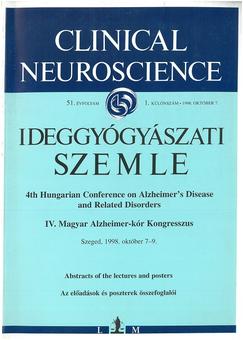The eLitMed.hu medical portal uses computer cookies for convenient operation. Detailed information can be found in the Cookie-policy.
Clinical Neuroscience - 1998;51(Különszám)
Content
Therapy of Alzheimer's disease: present and future
Cholinesterase inhibitors (ChEI) represent the drugs of choice for Alzheimer Disease (AD) treatment. Following a first generation of non specific drugs such as physostigmine, a second generation of more selective products was developed showing less severe side effects at effective doses.
Amyloid and Alzheimer's disease
To understand how the amyloid precursor protein gene (APP), the allele 4 of apolipoprotein E (apoEe4) and the two more recently-discovered presenilin genes PS1 and PS2 are linked to β-amyloid pathology, synaptic loss and neurodegeneration in AD, we have tried to consider what the physiological functions of these AD genes and of the βA4 amyloid peptide are.
Cholinesterase in Alzheimer's disease
After about two decades of intensive research in the field of Alzheimer therapy, a first generation of drugs to alleviate the symptoms and the symptomatic deterioration has now come to reality.
Neuroprotection and neurodegeneration
Studies with (-)-deprenyl (selegiline) revealed that it cannot be considered as a simple monoamine oxidase type-B (MAO-B) inhibitor, because its pharmacological activity is rather complex. The dopamine sparing activity as well as the neuroprotective and neuronal rescue effect of selegiline in the central nervous system (CNS) cannot be explained solely by its irreversible enzyme inhibitory action.
Animal models
The cholinergic hypothesis of cholinergic dysfunction in Alzheimer's Diseasc (AD) has stimulated an extensive amount of studies attempting to develop an idea! animal model of this hypofunction.The overall goal of these investigations has been the availability of an animal model that would mimic the neurochemical, neuropathological and behavioral deficits observed in AD, and would enable the testing of pharmacological strategies to reverse these deficits.
New results in Alzheimer's disease research
Populations of neurons at risk of death in Alzheimer's disease (AD) demonstrate perikaryal oxidative damage, including lipid peroxidation, nitration and free carbonyls, that are not found in normal aged individuals. Since these changes are seen whether or not the neurons display cytoskeletal pathology, we investigated whether metabolic abnormalities could initiate and promote these changes as well as their consequences on nucleic acid metabolism.
Amyloid-β peptide (I)
The characterisitic pathological features of the brain of Alzheimer's disease (AD) patients include, among other features, the presence of neuritic plaques composed of amyloid β peptide (Aβ) and the loss of basal forebrain cholinergic neurones, which innervate the hippocampus and the cortex.
Amyloid-β peptide (II)
Alzheimer's disease (AD) pathology is characterized by the deposition of insoluble proteins in the brain. Intracellularly, neurofibrillary tangles are formed in selected neurons and, extracellularly, amyloid deposits are found in the brain parenchyma and vasculature. These insoluble proteins are neurotoxic and inhibition of their production or enhancement of their degradation may prove beneficial to the AD patient.
The role of glial cells in Alzheimer's disease
It is not a long time since basic brain functions have been accepted to depend on neuronal-glial interactions. lt has been acknowledged that astrocytes stabilize cation homeostasis in the neuronal microenvironment and help to terminate neurotransmitter signals. The latter process bears particular significance in the vicinity of glutamate synapses.
Alzheimer's disease research in Hungary (I)
This study discusses the occurrence of Alzheimer dementia (AD), the clinical diagnosis, the different neuropathological criteria (Khachaturian, CERAD and Tierney), the incidence of mixed cases, "incipient" changes without dementia. The findings support the earlier conclusion thai vascular dementia (VD) is more frequent than AD in Hungary. An explanation is given for the differences in statistics between countries and cultures.
Trace metals and Alzheimer's disease
Alzheimer's disease (AD) is a neurological disorder characterized by progressive dementia. The cause of disease is unknown. Various hypotheses have been proposed to explain AD, e.g. environmental toxins, inadequate blood flow and energy metabolism. These hypotheses may suggest a possible role for elements as causative factor or element levels may be useful as a diagnostic aid for this disease.
General reviews on Alzheimer's disease
The incidence of dementing illnesses is increasing with the prolongation of lifespan. Consequently the interest of researchers, clinicians and pathologists turned especially to the problems of dementia. From the prognostic point of view two big groups of dementia can be differentiated: first of all the progressive forms of it, including the so called degenerative diseases and the dementias of vascular origin; and secondarily the reversible or better to say remittable dementias.
General topics
The C5a is a patent mediator molecule in the intlammation processes. Presence of its receptor (C5aR) has recently been reported in hippocampal pyramidal neurons in the mouse and the rat and in the TGW human neuroblastoma cell line.
1.
Clinical Neuroscience
[Headache registry in Szeged: Experiences regarding to migraine patients]2.
Clinical Neuroscience
[The new target population of stroke awareness campaign: Kindergarten students ]3.
Clinical Neuroscience
Is there any difference in mortality rates of atrial fibrillation detected before or after ischemic stroke?4.
Clinical Neuroscience
Factors influencing the level of stigma in Parkinson’s disease in western Turkey5.
Clinical Neuroscience
[The effects of demographic and clinical factors on the severity of poststroke aphasia]1.
2.
Clinical Oncology
[Pancreatic cancer: ESMO Clinical Practice Guideline for diagnosis, treatment and follow-up]3.
Clinical Oncology
[Pharmacovigilance landscape – Lessons from the past and opportunities for future]4.
5.



